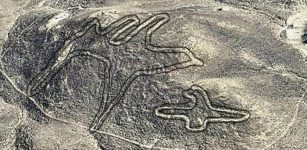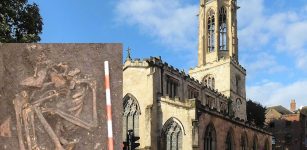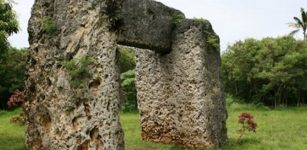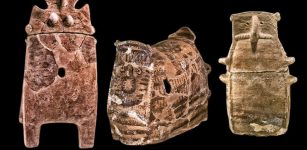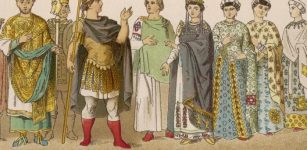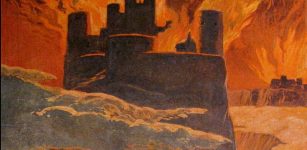People Of Old Dongola Recycled And Dyed Clothes
Conny Waters - AncientPages.com - The people of Old Dongola knew better than to throw away clothes that were worn out. In those days, before the Industrial Revolution, the production of fabrics was a very time-consuming activity. Scientists discovered people loved recycling by analyzing fragments of clothing found in residential spaces and garbage dumps in the urban part of Old Dongola. They were aware of the value of the fabrics and tried to use them as much as possible. Also, the color blue was especially sought-after because it could protect against evil forces.
Old Dongola temples. Credit: Adobe Stock - Thomas
The belief that the blue color can ward off evil spirits and harmful forces is widespread. Nazar amulets are especially popular in Turkey, but can also be "found in Macedonia, Albania, Bosnia and Herzegovina, Bulgaria, Greece, Cyprus, Syria, Lebanon, Israel, Egypt, Armenia, Iran, India, Afghanistan, Pakistan, Iraq, and Azerbaijan, are recognized by a blue glass bead. The Nazar symbol is associated with Turkey, but the symbol is very ancient, about 3000 years old and has its roots in Egypt and the benevolent eye of God Osiris who had protective powers against evil." 1
"In ancient Egypt and Greece, the color blue was used to protect a person or a place from evil spirits. Pharaohs were often dressed in blue. Egyptians and many other ancient civilizations considered the color blue to be of divine origin.
It’s, therefore, not surprising that the blue color was specifically chosen by our ancestors who wanted to protect their newborn from evil spirits that might be lurking about.
Traditional Nazar amulets. Credit: Adobe Stock - Ekaterina Pokrovsky
This ancient tradition is still alive, and there are many places in the Mideast where people still paint their doorways to ward off evil spirits." 2
People of Old Dongola, the capital of the Christian Kingdom of Makouria (7th - 14th century) in northern Sudan, shared similar beliefs. If they could get their hand on blue fabrics, they were delighted.
Scientists involved in the study of Old Dongola have made many intriguing discoveries in recent years. Research in this city was initiated by Professor Kazimierz Michałowski in 1964. Currently, intensive research in this place is conducted by scientists from the Polish Centre of Mediterranean Archaeology of the University of Warsaw (PCMA UW).
The discovery of unique wall paintings and stone blocks with pharaonic hieroglyphic inscriptions and figural decoration at the site of the medieval citadel in Old Dongola gave scientists the opportunity to piece together the history of this city before becoming a Muslim town. During the Middle Ages, Old Dongola had many churches and large houses, wide streets within a city wall, and, from 1002, a red-brick palace. Old Dongola was an important city in Medieval Nubia.
Scientists have paid attention to old wall paintings not only because they depict rulers and church dignitaries but also because a few scenes show average, ordinary residents.
A fragment of clothing, cotton dyed blue. Credit: Mateusz Reklajtis PCMA UW
"Fabrisc is a window that allows us to learn more about the lives of ordinary people of this city," researchers who conducted the recent study said.
Chemical analyses of 17 fabric samples found in Old Gondola show people dyed the clothes, making the clothes thicker, more durable, and lasting longer. In general, thanks to the dry climate of the Nile Valley, fabrics, leather, and wood are quite well preserved in this area.
Unfortunately, to dye clothes was costly, and only the wealthiest residents could afford a fabric that was all dyed, e.g., blue. In general, color was something rare, difficult to obtain, and expensive.
"Large sheets of fabric were not dyed on a large scale. The amount of coloured threads was limited. They were dyed in tiny vessels, and when the appropriate amount was collected, the fabrics were decorated while weaving: either using the upholstery technique or the brooching technique." 3
"Dyes of both plant and animal origin were used. Woad (Isatis tinctoria), a plant from the cabbage family, was quite commonly used for blue dyeing. Locally growing resedas gave yellow colour. The red colour was obtained by using local rose madder (Rubia tinctorum) and imported kermes (Kermes vermilio).
Local craftsmen also mixed various ingredients to obtain green or shades of orange. Some were applied directly to the fabric, others were fixed with special techniques using a mordant that helped maintain the colour.
Scientists also identified dyer's greenweed (Genista tinctoria) in the tested fabrics, which was used on a large scale in Europe then. They also found blue-dyed cotton, but it was often imported, primarily from Egypt.
A fragment of woollen fabric was decorated using the brooch technique. Credit: Magda Wozniak PCMA UW
Many imported products reached Nubia during this period. Apart from fabrics, which accounted for more than half of imports, other desirable products reached Nubia through the Nile and the desert, including tin, lead, small metal products (razors, files, mirrors, scissors, needles, thimbles), spices and beads, some were even imported from Europe or distant India.
Most clothes were made of wool, but "there is also a lot of fabrics made from cotton and there are indications that it was grown in this section of the Nile Valley. There is some linen, but surprisingly little of it. There are also fragments of silk, but they come from a single location identified as the home of a local ruler. This makes sense; only the elites had access to silk," Dr. Magdalena M. Wozniak from the Polish Centre of Mediterranean Archaeology UW said. 3
See also: More Archaeology News
The majority of women wore woolen clothes that were not sewn. It was usually a large piece of fabric that they wrapped around themselves in various ways.
Men mainly wore cotton clothes made of sewn pieces of fabric and resembled dresses, often with something blue on them.
"Children's tunics and collars were often trimmed with a strip of blue fabric. Not only did it look good visually, but it was also an amulet,’ Dr. Wozniak says.
Perhaps one should not be surprised people in the past came up with the idea to recycle and dye their fabrics because we have seen on many occasions how innovative ancient people were.
The study was published in the journal Archaeometry.
Written by Conny Waters - AncientPages.com Staff Writer
Expand for references





